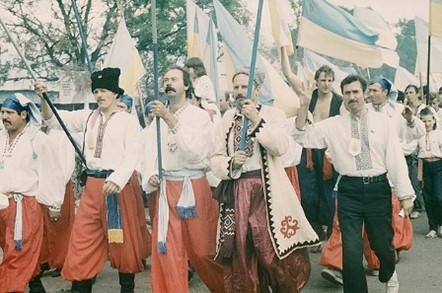Thursday 16 November 2023
The Culture of the Ukraine
By Rosamund Bartlett

The history and geography of Ukraine was skilfully interwoven with examples of art, music, dance, architecture and embroidery so that its culture could be understood. The lecture centred around Lviv, Kyiv, Odessa and the Cossacks who were originally itinerant groups in the North. Ukraine is now multi-ethnic and multi faith.
Ukraine and Russia were originally one country but when the people of Kyiv were searching for their own religion, they settled on the beliefs around the Hagia Sophia Mosque in what was then Constantinople, as it had beautiful singing and wonderful mosaics. The Greek monks taught reading and writing and translated the gospels. We were shown beautiful icons and mosaics in the cathedral. Music as another part of the culture was explored and we were treated to a video of the singing of a Dumas – an epic song – about the river Dnieper – accompanied by the playing of a Kobka which is a multi-stringed lute. The Kobka was originally played by itinerant Ukrainians during the Hetman era.
A talented painter, Taras Shevchenko, born a serf in 1814, became the great national poet of Ukraine and we heard some of his poetry about the Russian motherland. Another aspect of Ukrainian culture, dance, was displayed in a film of some very energetic Cossacks dancing a Hopak! The famous painting by Ilya Repin entitled “The Reply of Zaporozhian Cossacks to the Turkish Sultan” painted between 1880-1891 was explored showing the Cossacks’ response to the Sultan demanding acceptance of the Turkish rule. Ivan Mazeppa was one of the last great Cossack leaders and he began to restore religious buildings including the Church of the Assumption in Kyiv. He introduced the Baroque style.
Peter the Great founded St. Petersburg to which many artists and musicians migrated and one such painter was Dimitry Levitsky who was born in Kyiv and became a great Russian portrait painter. Catherine the Great extended the borders of the Russian Empire to include Kiev and she was a patron of the arts and literature.
Colour is at the heart of much of Ukraine’s culture even today, whether it be in painting on houses or embroidered shirts and family icons, where flowers or geometric designs symbolise the journey from earth to heaven. A triangle symbolises the Holy Trinity and a diamond pattern symbolises fertility. Ukrainian as a language was recognised in 1917 although Ukraine was not legitimised as an independent country until 1991.

